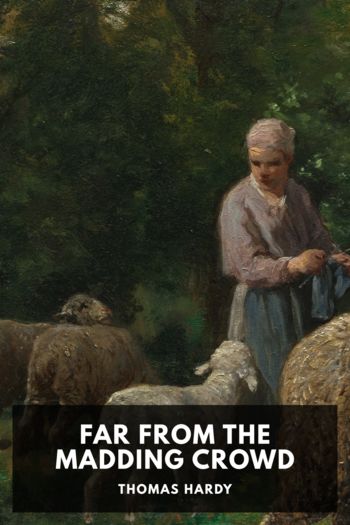The Woodlanders, Thomas Hardy [book recommendations for young adults txt] 📗

- Author: Thomas Hardy
Book online «The Woodlanders, Thomas Hardy [book recommendations for young adults txt] 📗». Author Thomas Hardy
Coming to a sudden resolution, he hastened along the garden, and entered the one attached to the next cottage, which had formerly been the dwelling of a gamekeeper. Tim descended the path to the back of the house, where only an old woman lived at present, and reaching the wall he stopped. Owing to the slope of the ground the roof-eaves of the linhay were here within touch, and he thrust his arm up under them, feeling about in the space on the top of the wall-plate.
“Ah, I thought my memory didn’t deceive me!” he lipped silently.
With some exertion he drew down a cobwebbed object curiously framed in iron, which clanked as he moved it. It was about three feet in length and half as wide. Tim contemplated it as well as he could in the dying light of day, and raked off the cobwebs with his hand.
“That will spoil his pretty shins for’n, I reckon!” he said.
It was a mantrap.
XLVIIWere the inventors of automatic machines to be ranged according to the excellence of their devices for producing sound artistic torture, the creator of the mantrap would occupy a very respectable if not a very high place.
It should rather, however, be said, the inventor of the particular form of mantrap of which this found in the keeper’s outhouse was a specimen. For there were other shapes and other sizes, instruments which, if placed in a row beside one of the type disinterred by Tim, would have worn the subordinate aspect of the bears, wild boars, or wolves in a travelling menagerie, as compared with the leading lion or tiger. In short, though many varieties had been in use during those centuries which we are accustomed to look back upon as the true and only period of merry England—in the rural districts more especially—and onward down to the third decade of the nineteenth century, this model had borne the palm, and had been most usually followed when the orchards and estates required new ones.
There had been the toothless variety used by the softer-hearted landlords—quite contemptible in their clemency. The jaws of these resembled the jaws of an old woman to whom time has left nothing but gums. There were also the intermediate or half-toothed sorts, probably devised by the middle-natured squires, or those under the influence of their wives: two inches of mercy, two inches of cruelty, two inches of mere nip, two inches of probe, and so on, through the whole extent of the jaws. There were also, as a class apart, the bruisers, which did not lacerate the flesh, but only crushed the bone.
The sight of one of these gins when set produced a vivid impression that it was endowed with life. It exhibited the combined aspects of a shark, a crocodile, and a scorpion. Each tooth was in the form of a tapering spine, two and a quarter inches long, which, when the jaws were closed, stood in alternation from this side and from that. When they were open, the two halves formed a complete circle between two and three feet in diameter, the plate or treading-place in the midst being about a foot square, while from beneath extended in opposite directions the soul of the apparatus, the pair of springs, each one being of a stiffness to render necessary a lever or the whole weight of the body when forcing it down.
There were men at this time still living at Hintock who remembered when the gin and others like it were in use. Tim Tangs’s great-uncle had endured a night of six hours in this very trap, which lamed him for life. Once a keeper of Hintock woods set it on the track of a poacher, and afterwards, coming back that way, forgetful of what he had done, walked into it himself. The wound brought on lockjaw, of which he died. This event occurred during the thirties, and by the year 1840 the use of such implements was well-nigh discontinued in the neighborhood. But being made entirely of iron, they by no means disappeared, and in almost every village one could be found in some nook or corner as readily as this was found by Tim. It had, indeed, been a fearful amusement of Tim and other Hintock lads—especially those who had a dim sense of becoming renowned poachers when they reached their prime—to drag out this trap from its hiding, set it, and throw it with billets of wood, which were penetrated by the teeth to the depth of near an inch.
As soon as he had examined the trap, and found that the hinges and springs were still perfect, he shouldered it without more ado, and returned with his burden to his own garden, passing on through the hedge to the path immediately outside the boundary. Here, by the help of a stout stake, he set the trap, and laid it carefully behind a bush while he went forward to reconnoitre. As has been stated, nobody passed this way for days together sometimes; but there was just a possibility that some other pedestrian than the one in request might arrive, and it behooved Tim to be careful as to the identity of his victim.
Going about a hundred yards along the rising ground to the right, he reached a ridge whereon a large and thick holly grew. Beyond this for some distance the wood was more open, and the course which Fitzpiers must pursue to reach the point, if he came tonight, was visible a long way forward.
For some time there was no sign of him or of anybody. Then there shaped itself a spot out of the dim mid-distance, between the masses of brushwood on either hand. And it enlarged, and Tim could hear the brushing of feet over the tufts of sour-grass. The airy gait revealed Fitzpiers even before his exact outline could be seen.
Tim





Comments (0)